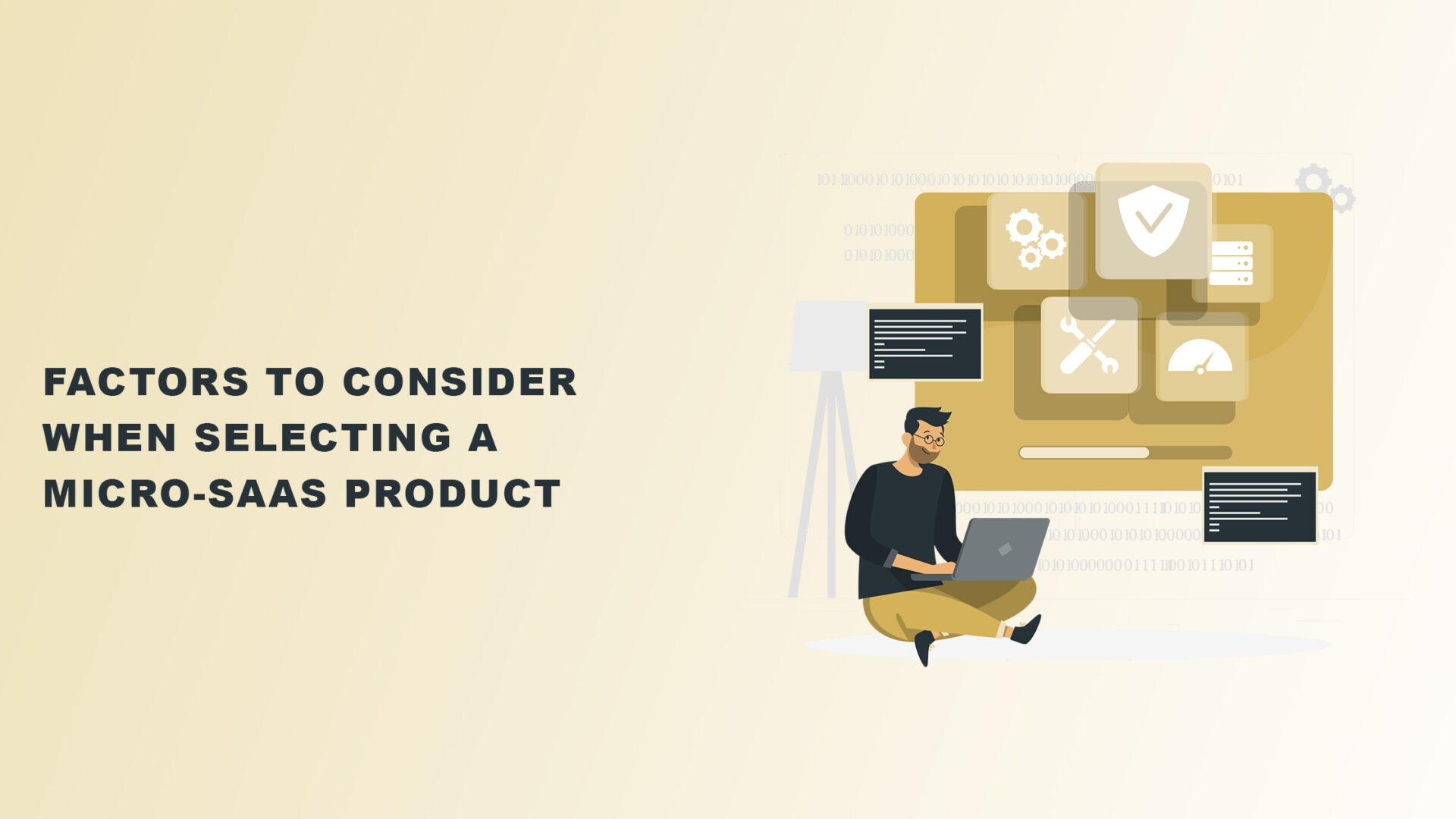Thinking of buying a business with a micro-SaaS product but have no idea which one to choose?
When selecting, there are several factors you should consider to find the best fit for you.
These factors include market demand, competition, customer support, the capability of the team behind the product, and a roadmap for future development.
This article will delve into each of these factors in more detail to help you make an informed decision when selecting a profitable micro-SaaS product.
1. Market Demand
Conduct market research to understand the demand for the product and whether it addresses a common pain point for a specific group of people.
Extensive market research will help you determine the potential size of the market and the level of competition you may face.
This information can help you decide whether there’s a viable market for the product and whether it’s worth investing in.
When evaluating market demand, it’s essential to consider the timing of the product’s release.
Is there a current trend or gap in the market that the product can fill?
Will the product be able to sustain demand over the long term, or is it a fad that will quickly lose its appeal?
Answering these questions can help you determine its potential success.
Here are some specific steps you can take to analyze market demand when considering a micro-SaaS product:
1.1 Research the Market

When researching the market, it’s crucial to identify your target market.
One way to gather information about your target market’s size and product demand is by doing online research, such as looking for industry reports, news articles, or other online resources.
Another way is by seeking out industry associations or professional organizations that can provide market research reports or data on market trends and demand.
Gathering feedback from potential customers is also helpful in getting insights into product demand and pricing.
1.2 Talk to Potential Customers
Gathering insights on demand and pricing for a micro-SaaS product is possible by reaching out to potential users.
You can do this through online surveys, email, social media, phone, or in-person conversations.
Ask them if they would be interested in the product and at what price point.
Just remember to be respectful of people’s time, though, and be clear about why you’re reaching out and how you will use their feedback.
The video below also illustrates how you can find pains that lead to micro-SaaS solutions you can rapidly grow.
1.3 Monitor Social Media and Online Communities

Looking for discussions on social media related to the product or the problem it solves will give you an idea of how much interest there is for the product.
Listening tools, specific hashtags, and keywords can track product-related mentions.
However, keep in mind that online conversations are just one aspect of the market and may not reflect the collective perspective.
Nonetheless, they should still be able to provide valuable insights.
1.4 Test the Market
Another way to test for demand is by running a small pilot or launching a crowdfunding campaign.
Doing this is a great way to test for interest and purchasing power and can help determine if there is enough demand to justify moving forward with product development or commercialization.
Running a pilot or beta test can show you how people interact with the product and whether they find it useful.
You can run it with a small group of people and gather feedback to see if the product meets their needs and addresses any pain points.
You can also use this as an opportunity to gather feedback on pricing, which can inform your pricing strategy.
Crowdfunding is another way to test the market by launching a campaign where you can pre-sell your product and gauge how many people are willing to purchase.
Doing this can be an easy way to measure how much interest there is in the product.
It also allows for some validation, giving you an idea of the product’s viability.
2. Competition
It’s essential to research the competition to understand the level of competition in the market and whether the product you’re considering differentiates itself from the competition.
Here are some factors to consider when analyzing your competition:
2.1 Compare the Product

When considering the product against its competitor tools, looking at features, ease of use, performance, scalability, and pricing is essential.
These aspects will help you determine how your product differs from the competition and whether it offers a unique solution.
Similarly, you can evaluate the ease of use and user interface and check if it is more user-friendly, is more intuitive, or has more features.
On the other hand, you can also evaluate the performance and scalability of the product, such as whether it can handle the workload and meet your business needs.
2.2 Look at Reviews
Reviews of competitor products can provide valuable insights into their strengths, weaknesses, and what customers think of them.
By reading reviews, you can understand what people like and dislike about the competition and identify opportunities to differentiate your product.
You can find reviews on the App Store, Google Play, other micro-SaaS marketplaces, the product’s website, third-party review sites, or even on social media.
Reading a diverse set of reviews from different sources will give you a more well-rounded understanding of the competition and customer preferences.
When reading reviews, it’s essential to pay attention to patterns in their feedback.
Look for common customer complaints or issues with the competition and consider how your micro-SaaS product can address these problems.
Pay attention to areas where competitors excel and see if your product can match or exceed those areas.
2.3 Analyze Competitors’ Business Models

Analyzing competitors’ business models can give insights into their revenue generation strategy and how they sustain their business.
A few business models in the SaaS industry include freemium, subscription, or one-time purchase models.
A freemium business model is one where a product or service is free, but some advanced features require you to subscribe to its paid plans.
This model can be a great way to attract a large user base and generate revenue through upgrades or premium services.
Meanwhile, a subscription-based business model is one where customers pay a regular fee (usually monthly or annually) to access the product or service.
It can be a stable source of recurring revenue for the company, but it also depends on the ability to retain customers.
On the other hand, a one-time purchase model is one where the customer pays a one-time fee for the product or service.
This model can be a good option for products that don’t require frequent updates, but it may not generate as much revenue as a subscription-based business model.
2.4 Monitor Competitors
In addition to analyzing their business models, it’s also essential to monitor your competitors’ actions on an ongoing basis.
Monitoring involves keeping track of any new product launches or changes to their marketing strategy.
This information can provide valuable insights into their product development and marketing plans.
There are a few different ways you can monitor your competitors.
One, you can set up Google Alerts for competitor-related keywords, subscribe to their email newsletter, or follow them on social media.
Alerts help you stay informed about their new products, updates, and promotions.
You can also monitor industry publications and trade journals or attend conferences to stay informed about any recent developments in the industry.
The goal is to keep you aware of any changes in the competitive landscape to stay informed about their product offerings and marketing strategies.
This way, you can quickly identify opportunities to differentiate your product and improve your strategy.
3. Customer Support
As a business, it’s essential to consider how you will handle customer support and whether the team can meet your customers’ needs.
When evaluating customer support, consider the availability of the team’s responsiveness, hours of operation, and communication channels.
Let’s examine some of these factors in depth.
3.1 Determine the Support Channels You Will Offer

For support channels, it’s essential to consider the needs of your target audience and the resources you have available.
Choose channels that will be most effective for your customers and most feasible for your business.
Email support is a popular option as it allows customers to contact you anytime, and you can reply at your convenience.
It’s also easy to scale and automate with the help of tools.
On the other hand, chat support is also a popular channel for providing real-time assistance to customers.
It allows for easy and instant communication, which can be a great way to resolve issues in real-time.
3.2 Set up a System for Tracking and Responding to Customer Inquiries
Once you have determined the support channels you will offer, have a system that will help you keep track of customer inquiries and prioritize them based on urgency and importance.
A ticketing system or a customer relationship management (CRM) tool can be a helpful way to set up this system.
These tools allow you to create, track, and respond to customer tickets and keep all customer interactions in one central location.
They also provide a way for customers to get in touch with you and track the status of their inquiries.
It can also automate specific processes such as follow-up, alerts, and notifications.
When setting up the system, establish clear protocols for responding to customer inquiries and ensure that all team members are aware of and trained on how to use it.
Be sure to integrate it with other tools for your operations, such as email or chat platforms.
3.3 Determine the Response Times and Service-Level Agreements

Another critical aspect of customer support is determining response times and service-level agreements (SLAs).
Setting expectations with users on how quickly they can expect a response to their inquiries and being transparent about that can help manage customer expectations.
Determine a realistic response time that considers the available resources and the volume of customer inquiries you expect to get.
Doing this will ensure that they are satisfied with the level of service they receive.
On the other hand, it also won’t hurt to have service-level agreements (SLAs).
A formal commitment to a certain level of service, SLAs guarantee customers that they will get a response to their inquiries within a specific timeframe.
SLAs can be especially useful for more critical issues, such as outages or data loss, as they provide customers with a sense of security.
3.4 Train Support Staff
One of the critical factors in providing excellent customer support is ensuring that you train your support staff adequately.
Proper training will help confirm that your team can handle customer inquiries and issues promptly and effectively.
Doing this will, in turn, improve customer satisfaction and help maintain a good reputation for your business.
3.5 Set up a Knowledge Base

Setting up a knowledge base provides customers with the information they need and reduces the workload for your support staff.
A knowledge base is a collection of articles, FAQs, and documentation that customers can access on their own to find answers to common questions quickly.
Doing this can reduce the number of support requests and help ensure that customers are satisfied with the level of service they receive.
It can also empower customers to resolve issues on their own, thus reducing the support staff’s workload.
4. Team
The team behind your product will play a critical role in its development and success.
Therefore, evaluating the team members’ qualifications, experience, and track record is essential.
Here are some pointers to help you gather a well-rounded team:
4.1 Define Roles and Responsibilities

Clearly define who is responsible for what and ensure everyone on the team understands their role and what they need to do.
Well-defined responsibilities help ensure that everyone works together effectively and that there is no overlap or confusion about who is responsible for different tasks.
Moreover, it creates an organized and cohesive team that communicates effectively, achieves goals, and fosters a positive work environment.
4.2 Hire Team Members
Once you clearly understand the roles, it’s now easy to determine what qualifications and experience you require.
You can hire team members through online platforms such as LinkedIn, Indeed, Glassdoor, or remote work platforms.
You can also reach out to universities or technical schools and offer internships or co-op programs for students.
Word of mouth, networking, and referral can be valuable ways to find the right people to join your team.
4.3 Set up a Project Management System

A project management system will help you keep track of progress, assign tasks, and communicate effectively with the team.
Consider your team’s specific needs when selecting a project management system.
Some systems are more suited to small teams, while others work better for larger, more complex projects.
Additionally, it’s essential to select a system that is user-friendly, easy to navigate, and integrates with the other tools and software your team is already using.
4.4 Establish Clear Communication Channels
Another thing you have to consider is the communication methods you will use.
Establish a schedule for regular meetings, check-ins, and progress reports and set expectations for how quickly team members should respond to communications.
An open-door policy can help ensure that team members feel comfortable bringing up issues and concerns and foster an environment of transparency and trust.
4.5 Encourage Collaboration and Teamwork

Create a culture that promotes teamwork and open communication and provides opportunities for team members to work together.
Doing this will help build stronger relationships and improve team cohesion.
This way, you can foster a productive, successful, and cohesive team.
5. Product Roadmap
A clear and well-defined roadmap lays out the product’s future development and growth plan, is realistic, is achievable, and can be regularly reviewed.
A good product roadmap can give you confidence in the product’s long-term prospects and help you decide whether it’s the right fit for your business.
Here’s how you can come up with a roadmap for your product.
5.1 Define Your Vision for the Micro-SaaS Product

Your vision should outline the overall goal and direction of the product and how it aligns with your business objectives.
Consider the problem the product will solve, the target audience, and the features and functionalities essential for its success.
Aligning your vision with the product roadmap and overall business strategy will ensure that the product is a good fit for your business and will help you achieve your objectives.
5.2 Identify Critical Areas for Growth
Identify the areas where the product has the most growth potential and ensure that it will continue to meet the market’s and customers’ needs over time.
Consider things like scalability, potential new market segments, opportunities for partnerships or acquisitions, and the team behind the product and the company.
5.3 Prioritize Features and Improvements

It’s essential to consider your target audience’s needs, the competition, and feedback from early adopters or beta testers.
Prioritizing features and improvements based on their impact on the product’s overall value proposition and user experience will ensure its ability to meet the market’s needs.
5.4 Establish a Timeline
It’s also important to consider things like the development and testing of the product, the launch date, and the timeframe for post-launch support and maintenance.
Establish milestones and deadlines for critical stages of the development process, and be realistic about the time frame.
Doing this will ensure that you can develop and launch the product promptly in accordance with your business objectives.
5.5 Communicate the Roadmap to Stakeholders

By communicating the product’s development and growth plan, stakeholders can understand how the product aligns with business objectives.
This also increases the chances of them being more likely to support the product’s vision and goals.
5.6 Review and Update the Roadmap Regularly
Review and update the roadmap regularly to ensure the product stays aligned with the changing market, consumer needs, and your business objectives.
Gather feedback from stakeholders, customers, and the market and re-evaluate the product’s goals and milestones. This will let you update your marketing strategies regularly.
Final Thoughts on Selecting a Micro-SaaS Product
When considering a micro-SaaS product, it’s crucial to carefully evaluate the various factors that can affect its success.
From assessing market demand and competition to considering how it will be communicated to stakeholders, each aspect plays a vital role in the product’s success.
Thoroughly evaluating these factors will help you make informed decisions and select micro-SaaS business products well-suited to your needs.
Remember that this is not an exhaustive list; you can consider more aspects, but these principal factors should guide your selection process.
Feel free to check out our guide on micro-SaaS for sale if you’re looking for a complete guide to buying and selling a micro-SaaS business.
We also have an article that walks you through the different ways to manage a micro-SaaS company.

